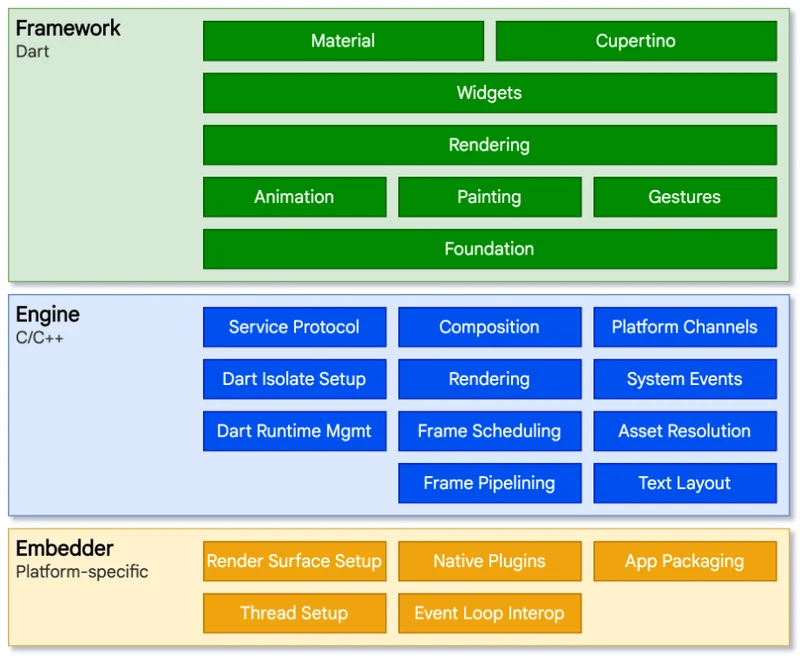Everything You Should Know About Flutter Documentation PDF
Cross-platform applications are a major topic of discussion in businesses and development teams today. Customers are typically spread out across multiple platforms and systems — each with their own technical requirements, operating systems, and methods of interaction. The biggest technical challenge businesses have now is reaching all their customers across each of their platforms while delivering consistent, high-quality applications that exceed user expectations.
The Flutter development framework is a key solution to doing precisely that. Here, we've created a Flutter documentation PDF to outline everything your business needs to know about Flutter to reach customers with stand-out applications.
With decades of combined Flutter experience each, our top-rated Flutter development companies regularly create high-quality cross-platform Flutter applications for a range of diverse clients in the healthcare, gaming, and tech industries amongst others.
Here, we take a look at what Flutter is, what makes it stand out amongst other competing technologies, and why you should consider adopting the framework for your next application whether it's on desktop, mobile, or the web.
What is Flutter?
Flutter is a robust, reliable, and performant framework for creating cross-platform applications. The open-source platform is most notably capable of building applications that span Android, iOS, Linux, macOS, Windows, and the web from a single codebase. For engineers, Flutter is essential for building applications across each of these platforms with near-native runtime performance, exceptional UI and UX design credentials, and a remarkable set of development tools and resources to aid application development.

First released to developers as an alpha back in 2017, Flutter has grown a remarkable community and ecosystem in a short amount of time. In the last two years alone, Flutter has recently surpassed React Native as the most popular cross-platform framework used by developers. Despite launching an entirely new toolset in a language that was almost entirely unknown at the time — Flutter has evolved and grown in popularity and use within development teams on its technical credentials alone.
A large part of the Flutter framework's popularity and productivity comes down to the technologies and techniques it employs to build applications. In this regard, Flutter is more than just an application framework for developers to target.
In technical terms, Flutter is a complete SDK (software development kit) that includes many of the libraries, tooling, and behind-the-scenes technical features that contribute to creating a fully-featured cross-platform application. Our recently updated ultimate guide to Flutter development takes a detailed look at the technology, how it's used amongst development teams, and how to use its unique advantages to benefit your business in real-world application development.
What Makes Flutter Stand Out Amongst Competing Technologies?
Looked at as a complete SDK, Flutter's primary advantages come from its unique design and architecture. Broken down into 3 main layers, this unique architecture allows applications to be written once and run anywhere through separating concerns between rendering, running, and platform native operations.

It's this design that leads Flutter to consistently stand out amongst the top mobile application frameworks available today.
At the heart of Flutter's architecture is the Flutter engine. This engine contains all the Flutter runtime components, Skia rendering engine, Dart tooling, and additional services that go into making Flutter applications highly performant and customizable. Flutter's engine is the powerhouse of the development kit that makes Flutter code work consistently across multiple platforms.
The lower embedder layer works directly with the engine, interfacing with the underlying target platform and making system calls to access platform-specific functionality. Each of Flutter's many available targets has its own embedder that can be introduced simply by adding an additional web, mobile, or desktop target in the application setup. Developers almost never have to worry about the embedder layer, and very rarely interface directly with the engine layer in their application code.
When creating a Flutter application, developers are most commonly concerned with the framework layer that interacts with the engine. It's this layer that will define application functionality; set the theme, layout, and user interactions; and define the plugins and libraries necessary for the application's functionality.
Typically, when comparing Flutter with other cross-platform frameworks and related technologies, developers are comparing Flutter's framework layer against complete technology solutions. It's important for businesses and technology experts to keep in mind that the two additional layers beneath the framework are doing the majority of the heavy lifting, however.
Why Choose Flutter for Application Development?
Having covered what it is that makes Flutter so unique, let's take a look at why you might want to utilize the technology for real-world development challenges. Many mobile, web, and desktop development companies are shifting to Flutter for the practical benefits it's delivering for their teams.
Enabling Rapid Application Development
Flutter offers developers the opportunity to reduce the time-to-market they can achieve for their applications. Leaning on the platform's highly modular architecture, increased code reuse between platforms, and improved development tooling — one of Flutter's primary selling points is its ability to increase productivity and unlock efficiency within development teams.
Remarkable UI Customisation
Exceptional user experiences and high-quality application interfaces have always been first and foremost in Flutter's design priorities. Quality user interactions are key to the success of modern Flutter apps and the continued advancement of the Flutter framework. While many frameworks are opinionated about what developers can do with application design, Flutter boasts of providing “control over every pixel” to allow truly customizable applications.
High-Quality Developer Support
The rapid growth in Flutter's popularity and use has contributed to a booming industry in resources, support, and development expertise in the framework. As an open-source tool, Flutter is well-placed to take full advantage of developers contributing time and effort into the project. Recent improvements to the platform have included Hot Reload, continuous integration tooling, IDE improvements, and the kind of outstanding documentation that Google often provides for projects.
Code Reuse Across Many Platforms
In addition to making development teams more efficient and productive, the ability to reuse code across multiple desktop, mobile, and web environments contributes significantly in other areas too. Future app changes can be made once and applied everywhere in a way that is difficult for other platforms to match. Time spent documenting, maintaining, upgrading, and reviewing code within the team can be potentially reduced merely by adopting Flutter Technologies.
How To Apply Flutter Technologies in Your Business
The final key to bringing the technology advantages of the Flutter framework into your organization is in the way you hire and deploy development teams within your business. This area of hiring Flutter developers is crucial to the success of your projects and is well worth investing time and research into doing well.
Matching the right kind of development experience with the right developers and practical expectations will ensure things run smoothly from the first day of development onwards. Here are a handful of key tips we regularly follow to do the right kind of due diligence when it comes to researching development teams.
- Look for a strong portfolio of apps in related industries with similar expectations. The apps a development company has built in the past are one of the best indicators you can get of what they are capable of building in the future. Look for apps with design credentials you'd be happy representing your firm with and the kind of technical features that could benefit your projects.
- Analyze case studies and reviews thoroughly. Read what previous clients had to say about working with the team and how well they felt they were able to reach their goals. Reviews tell you a lot more about the soft skills a team brings to the table than just their technical abilities.
- Review your own communications with the team. When you've chosen a Flutter development company for the project, pay close attention to communications and expectations early in the project. Look for styles of communication that fit closely with your internal expectations and find a team that has a similar style and outlook.
Conclusion
As we've shown here, the popularity of Flutter today is much more than just a fashion trend that passes through software development. Much like web 2.0, IoT technologies, or always-connected mobile devices, Flutter is a paradigm shift in cross-platform application development that offers a great deal to the teams that deploy it.
This Flutter documentation PDF should be an ideal introduction to the advantages of Flutter, how to use it, and why you should be considering it for your next project. With these facts in mind, take a deep dive into our Flutter development resources for a more thorough look at the technology and its use in your business.
FAQ
Q1. What is Flutter used for?
Flutter is an open-source toolkit for creating natively compiled applications for mobile devices, desktop computers, and the web. The key advantages of Flutter come from allowing developers to write an application once, in the Dart programming language, and deploy it to multiple targets, devices, and operating systems with few modifications.
As a UI-focused toolkit, Flutter boasts being able to create attractive applications that put the user interface and user experience front and center amongst design concerns. Developers often take advantage of the design credentials of Flutter applications to create applications with strong aesthetic design choices.
Luxury car maker BMW is one example of developers fully utilizing the rich user experience that Flutter applications provide. The car manufacturer has published a Flutter application that interfaces with their vehicle's comfort control system. Toyota, eBay, and Stadia each have applications of their own that deliver similarly powerful user interactions.
Q2. Why is Flutter not popular?
In comparison to its closest competitors, Flutter is a highly popular technology in its field. Despite being a comparatively new technology, Flutter has quickly grown to catch and surpass its closest competitors in React Native and Xamarin. For context, more than 12.5% of developers have used Flutter to create applications while less than 10% have ever used Kotlin.
Flutter's growth in popularity has been limited to some degree by the framework's reliance on the Dart programming language. Originally developed and used in-house at Google, the decision to launch a cross-platform technology using a relatively obscure language surprised many at the time. Yet, despite very few developers being familiar with Dart 5 years ago, both the language and the Flutter framework have proven their value in the hands of developers.
Q3. How do you use Flutter documentation?
For developers or enthusiasts new to Flutter, starting at the introduction to the language is a great way to learn how to fully utilize its tools. Flutter boasts some of the most remarkable documentation and tutorials of any framework or technology currently available. Developers can use these written resources, code samples, and YouTube videos to take a virtual degree in programming and designing applications in Flutter.
Learning how to use widgets and composing Flutter applications effectively is one of the crucial starting points in designing for Flutter. When you've got to grips with widgets, their advantages and their limitations, understanding UI constraints is the next key stopping point for learning good Flutter practices.
Even with only these two ideas fully understood, you're effectively ready to start building in Flutter and learning application design, development, and engineering through practice and experimentation. Luckily, whatever problem you come across along the way can be readily solved through the platform's remarkable documentation resources.
